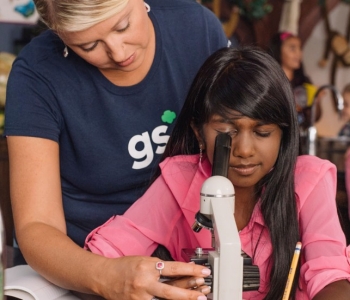Step Back and Let Your Girls Take the Lead

One helpful Daisy spills handfuls of popcorn while passing a large snack bowl around the room; another excitedly squeals when she hears you might move the meeting outside and sprints toward the door with four other enthusiastic Daisies. At this moment you, as the troop leader, might be wondering, “Girl-led, or girl-led chaos?”
Girl-led activities are the secret sauce of Girl Scouting, and it’s easy to see why. When girls step up and take ownership of their decisions, they grow into confident leaders who can make informed and empowered decisions—a valuable skill they’ll carry throughout their lives.
For new troop leaders, however, stepping aside and letting the girls take charge might seem counterintuitive, especially if you lead a troop of energetic Daisies or Brownies. And because girl-led activities start with you, how can you create a space where girls feel empowered to speak their minds and pursue their interests?
“For me, girl-led programming means taking a step back as a leader and involving the girls in the decision-making process as early as possible to the extent of their abilities,” explains Silvia La Falce, a Girl Scout Ambassador troop leader at Girl Scouts of Greater Chicago and Northwest Indiana. “It means helping them brainstorm together what they want to explore, achieve, or try in their Girl Scout year; guiding them in their discussions and compromising; and helping them achieve their goals.”
Trina Floyd, a Girl Scout Junior troop leader with Girl Scouts of Western Ohio, agrees. “As leaders, we give suggestions that will help the girls go in directions they want to go, while allowing them to make the final decisions.”
Just how active a role a leader takes in troop life will look differently across Girl Scout grade levels, but below are a few ideas from our Volunteer Experts.
“Girl-Led” for Younger Girls
Whether your girls are selecting a Journey or planning an event, they’ll need your support as they learn to take the reins. Girl-led for your Daisies and Brownies could mean that you consolidate their ideas and offer guided questions to help them reach decisions. Juniors will have more focused thoughts about what they’d like to do during their troop year but may need some support as they start planning activities. You might encourage them to review GSUSA’s Safety Activity Checkpoints document ahead of an outdoor activity or use the Volunteer Toolkit to help plan meetings.
According to Trina, understanding what your younger girls want to accomplish makes guiding them easier. “Remember that young girls don’t know half the information you know,” she advises. “When giving girls choices, remember what their goals are to help keep them on track. My [Junior] troop is a talkative and energetic bunch; sometimes it’s hard for them to stay focused, and because of that they [haven’t always wanted] to take the lead at meetings. But that changed this summer when one of the girls asked if she could lead—this was a great moment for me because then more of the girls said they want to lead a meeting and now they’re planning the meetings for the rest of the year.”
In short? Be patient and understand that not everything will be as organized as you intended, and that’s OK! What really matters is that your girls are empowered to make age-appropriate decisions about troop activities.
… And for Older Girls
Girl Scout Cadettes, Seniors, and Ambassadors can take on more responsibilities, but your role as an advisor is still key as your girls hone practical skills that will benefit them throughout their careers, like planning an event from start to finish, taking the lead on a service project, or budgeting for activities.
“A few years ago, when my girls were Cadettes, they organized an event to teach younger girls and newer leaders the Girl Scout traditions,” remembers Silvia. “They were completely in charge of planning what they thought was important to pass on to the younger girls: songs, games, snacks, and Juliette Low's Eternal Flame ceremony. They had to stick to our troop’s budget while keeping the cost low for the attending girls. In the end, they owned their event; they felt proud of their accomplishment and they could evaluate it objectively. It probably would’ve been easier and faster for the leaders to take control of some aspects of the planning, like selecting the venue, shopping for supplies and patches, and even filling out the service unit evaluation form. But it was a very powerful learning experience for the girls that they wouldn’t have had otherwise.”
Understanding your girls’ interests is essential to keeping them engaged, so encourage them to think big and tailor activities as they see fit. Talk to them about what they value and what they want from their Girl Scout experience, which will become even more meaningful as your older girls pursue higher awards. Sure, they’ll be making outreach to local charities and facilitating community workshops—but you'll be the one they turn to when they need advice or words of encouragement as they encounter roadblocks in their projects.
It might be tempting to step in for girls of any age, but remember that giving them space to make their own decisions—and mistakes—is how they’ll tap into their most confident selves. “It’s sometimes hard to step back and let the girls lead,” admits Silvia. “Girls can feel somewhat uncomfortable; after all [they’re probably not] used to being the ones in charge of making decisions very often. But practice, though it might not make perfect, helps, and the sooner [your girls] get used to the process, the easier it becomes. And letting girls take the lead will often get us all out of our comfort zones, which is a good thing—for girls and adults.”





